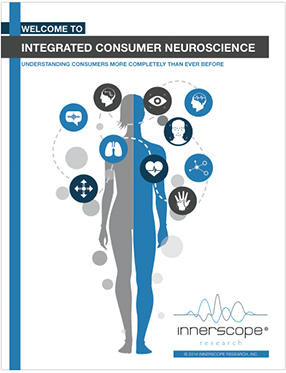Co-founder and Chief Science Officer of Innerscope Research, Dr. Carl Marci, knows the importance of a connection. Whether it’s a connection between people, a connection to a brand, or the connections formed in our brains, they all point to a unifying factor – emotions matter. In this two part blog series, we will first navigate how empathy is created in the digital age through Dr. Marci’s lecture given at the Marketing Science Institute. In Part II, we will explore what a (biometric) day in the life looks like across generations. Dr. Marci takes us on a journey through patient-doctor relationships, neurobiology, and our lives in the digital world to get to the bottom of our emotional engagement with the world around us.
The talk, Creating Empathy and Intimacy in the Digital Media Age, begins by defining empathy as the ability to understand another person’s state of mind. This ability to understand others serves as an emotional guide to intimacy, where you’re actually able to “put yourself in the shoes of others.” The debate for years, however, has been whether we unconsciously connect with people and things or whether we need to be consciously aware of these connections. What we know is that the mind and brain work unconsciously to guide us through our understanding of others. Tapping into his background in psychiatry, biological psychology and neuroscience, Dr. Marci launches into an exciting and interesting roadmap of empathy, and how we’re using it, even when we don’t know it.
The sweat gland may seem like an odd way to first explore empathy and emotion, but it’s in part thanks to these microscopic tubes that Innerscope has been able to measure emotional responses with such precision. Each gland is a target to which a network of neurons starting in the emotion centers of the brain ultimately connects. Thus, the action of producing sweat originates in the brain, due to our responses to perceived stimuli in the outside world. The measurement of these sweat glands is used to produce skin conductance graphs, which show your body’s physiological response to any emotional moment. It’s a quantitative way to measure how your body is responding to the world on an emotional level, and when combined with other measures, gives us a glimpse inside our minds.
Besides quantifying electrical impulses on our skin, Dr. Marci was also able to quantify laughter moments while working at Massachusetts General Hospital. So what do sweat glands and laughter have in common? They can both be used to measure emotional engagement in depressed patients. Because of his ongoing interest in relationships and psychotherapy, Dr. Marci kept coming back to a pressing question: How could talk therapy, without surgery or medication, produce the powerfully positive outcomes in patients with depression or anxiety?
In an attempt to answer this question, Dr. Marci measured the neurophysiological responses of both doctor and patient during a therapy session. He found that both sides of the relationship matter – when patients or therapists laughed alone, they exhibited a measureable emotional response, but when patients and therapists laughed together, the emotional response was significantly amplified. This concordance of laughter and connection between patients and doctors proved to be a form of non-verbal empathy. It seems they got it right when they said, “Laugh and the whole world laughs with you!”
Dr. Marci continued on to explore the neurobiology of empathy. The brain is wired to make us emotional beings. 1/3 of the brain’s energy goes into regulating and managing emotional responses, so it’s no surprise that emotions play a huge role in our ability to connect with one another and our world around us. We all possess a network of mirror neurons, which are used to take information about an external object, understand it, and then play it back to acquire meaning to us. This mirror neuron system is what we tap into when we try to understand one another. Have you ever seen a friend go through something so painful that you seem to feel some of his or her pain? That’s no coincidence – the same networks in your brain activate when you observe pain as when you experience pain. The response is attenuated, but can increase depending on how close your relationship is with the person you are observing.
So our ability to empathize and emotionally engage with others runs deep in our brains and even influences our bodies. Can we possibly display that same emotional connection with media? And if so, what does that mean for the world of marketing? In Part II of this blog series (coming next week) we’ll explore how our bodies respond to digital media across generations. You might be surprised by the results.
Watch Dr. Marci’s full presentation: Creating Empathy and Intimacy in the Digital Media Age



Leave A Comment